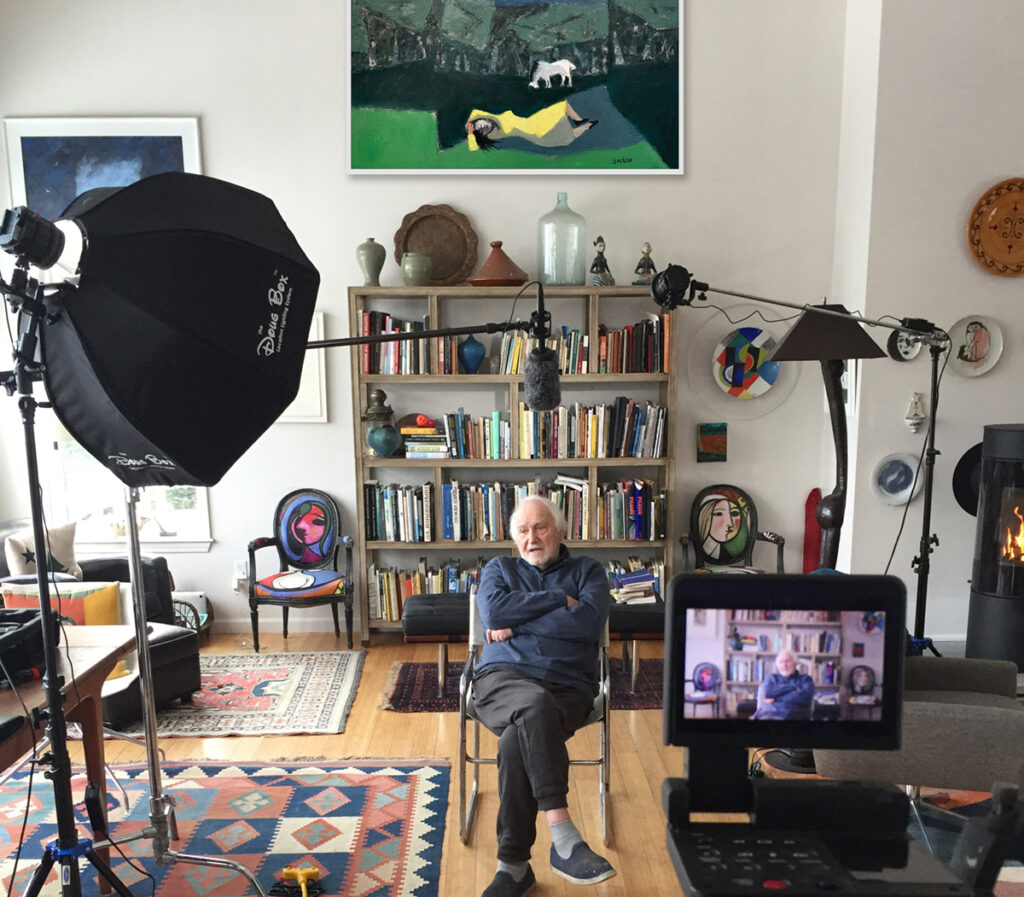Film Premier at The Grand
Premier Screening of the Film: “William Irvine: A Life Behind the Canvas”
Courthouse Gallery Fine Art hosted the premier screening of “William Irvine: A Life Behind the Canvas,” at The Grand in Ellsworth on Sunday July 23. The film is first documentary on the 75-year career of iconic Maine painter William Irvine (b. 1931).
Now Available in DVD!
Please enjoy the trailer!
A Life Behind the Canvas is produced by Whisky Wolf Media, a production company based in Brunswick, Maine. In 2020, David Jester and Leigh Doran began filming countless hours of interviews with Irvine at his waterfront home in Brooklin, Maine. Granting the filmmakers rare access to his painting studio, Irvine, whose impressive oeuvre spans seventy-plus years, shares his insight into a life in art.
Beginning on the shores of Troon, Scotland, where Irvine was born and raised, “Behind the Canvas” chronicles his artistic journey from his early beginnings at the Glasgow School of Art and subsequent start as an abstract painter in the Bohemian neighborhood of 1950s Soho London, culminating with his eventual move to downeast Maine 1968. In the Maine villages of Jonesport and Corea, and later in Blue Hill and Brooklin, Irvine began pairing his abstract background and expressionist sensibilities with Maine’s landscapes. Irvine’s abstract overtones and his underlying geometric forms made his iconic Maine paintings both assessable and modern, and established him as a Maine and American master, and a notable and influential abstract-expressionist twentieth-century Scottish-American painter.
Utilizing never-before-seen archival footage interwoven with present-day footage, the film provides an intimate portrait of Irvine’s artistic endeavors as he recounts historical moments during the twentieth-century, including World War II Scotland, the gritty, industrialized streets of Glasgow, and the bohemian neighborhood of 1950s Soho London where Irvine rubbed shoulders with the likes of Francis Bacon, Paul Potts, and William Crozier, and where he came of age as an abstract painter.
The never-before-seen archival footage was shot by Irvine in the 1960s, when he went to Provence in the south of France to make a film about Vincent Van Gogh. Irvine planned to film the outside of the nineteenth century asylum and monastery in Saint-Rémy where Van Gogh spent a year as a patient and created over 150 paintings. Upon his arrival, Irvine discovered that the old building was about to be demolished. While the workmen were having lunch in a field, Irvine and his wife slipped inside where they explored the gardens and the interiors, eventually making their way to the cells with bars on the windows and doors. Using a Bolex 16mm camera, Irvine was able to film a great deal of the landscape and the interior, including a cell looking out the window at the olive trees in the garden. Although Irvine abandoned the project due to the high cost of film, this never-before-seen footage survived and is included in “Behind the Canvas.”
Whisky Wolf Media is an award-winning Maine based production company with a diverse portfolio serving all people’s of Maine and beyond its borders. The filmmakers are focused on telling compelling stories through documentary and narrative film. They seek to animate stories for future generations to enjoy and learn from, to further the historical record, and to advance the human condition through storytelling, film, and visual media. The media group is based in Brunswick, Maine. For more information visit www.whiskywolfmedia.com.
William Irvine was born in Troon, a small coastal village in Scotland. He was captivated by art as a boy, and by the time he was fourteen, Irvine knew painting would be his life’s pursuit. In high school, Irvine was introduced to modern art when the family of whiskey magnate Johnnie Walker invited Irvine to view Walker’s collection. After graduating from the Glasgow School of Art and serving in the Scottish army, Irvine came of age in London where he was an abstract painter and part of the lively 1950s avant-garde Soho art scene.
In 1968, Irvine moved to downeast Maine, and was immediately drawn to the fishing villages of Corea and Jonesport, whose tidy houses reminded him of the white farms dotting the green hills of Scotland. Here, harbor, boats, islands and the sea and sky, inspired bold new work fueled by two driving forces: abstraction and representation. Irvine’s reductionist sensibilities, and the richness of his textural compositions bring these two antithetical elements into balance.
“The power of Irvine’s work is his ability to pare a scene down to its essentials—the arrangement and scale of forms, the selection and intensity of colors—while retaining a sensation of physical presence and feelings. His abstracted seascapes are testament to this. Employing the horizon line as the constant, clouds and their corresponding reflections are offered in a great array of shapes, sizes, and colors, conveying the sea’s infinite variety. While seemingly abstract, to those that have experienced life at sea, the effects are accurate, and palpable. —Suzette McAvoy
Two books have been published on Irvine’s work and career: William Irvine: A Painter’s Journey by Carl Little (Marshall Wilkes 2014); and William Irvine: At Home (Marshall Wilkes 2018).
